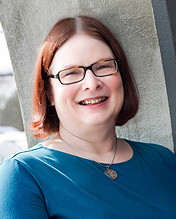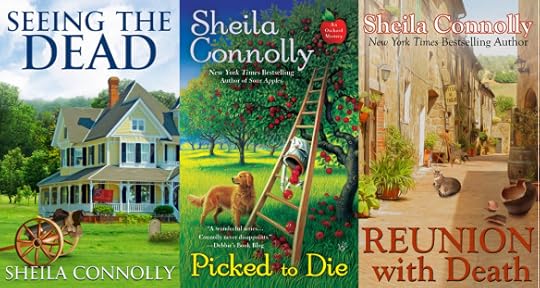Sherry Harris's Blog, page 36
October 14, 2014
The Most Wonderful Time of the Year
By Liz, in foliage-filled eastern Connecticut, looking forward to Halloween!
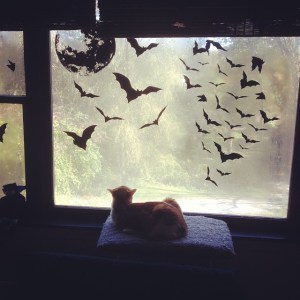 It’s officially my favorite time of the year: Halloween season. My decorations went up this past weekend. I’m late to the party this year. Usually the halls are decked with witches, ghosts, goblins, cats and bats by the end of September.
It’s officially my favorite time of the year: Halloween season. My decorations went up this past weekend. I’m late to the party this year. Usually the halls are decked with witches, ghosts, goblins, cats and bats by the end of September.
I am the quintessential Halloween junkie. It’s a natural fit, given my long-time love of all things creepy and scary. As a kid, I always begged my parents to let me watch the scary movies – then kept them up all 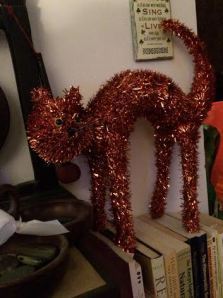 night because I was scared to death. Like the first time I watched Halloween and imagined Michael Meyers in my closet. But I still wanted to watch more. As a teenager, I had posters of Freddy Krueger on my wall, which really made my parents shake their heads (whose kid is she, anyway??). I dressed up like Freddy for a Halloween or two, complete with the glove. I even practiced the “Freddy voice” to entertain my friends in the halls. Yep, I was the quirky kid.
night because I was scared to death. Like the first time I watched Halloween and imagined Michael Meyers in my closet. But I still wanted to watch more. As a teenager, I had posters of Freddy Krueger on my wall, which really made my parents shake their heads (whose kid is she, anyway??). I dressed up like Freddy for a Halloween or two, complete with the glove. I even practiced the “Freddy voice” to entertain my friends in the halls. Yep, I was the quirky kid.
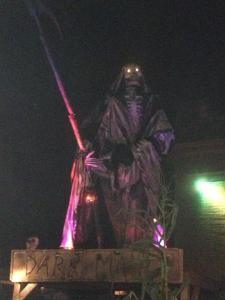 My quest for haunted things brought me to haunted theme parks like Spooky World, where crazed killers chased your hay ride with axes and bloody figures popped up from corn fields. I was always the one begging my friends to go to haunted houses or ghost tours. I couldn’t get enough.
My quest for haunted things brought me to haunted theme parks like Spooky World, where crazed killers chased your hay ride with axes and bloody figures popped up from corn fields. I was always the one begging my friends to go to haunted houses or ghost tours. I couldn’t get enough.
I chose Salem, Mass. as my college destination, partly for the English program and partly for the witchy experience. I was in heaven the entire month of October during Haunted Happenings – it was a constant costume party. Zombies, Disney characters and other interesting faces mingled with the college students most nights. The metaphysical  bookstores were packed. Laurie Cabot, Salem’s official witch, attracted followers at her store for readings and signings. There were witches’ balls, haunted tours, candlelit walks through history, visits to the site of the long-ago hangings. I loved every minute of it. To this day, I try to visit Salem at least once during its busy season. The dogs love to go too – they get to dress up.
bookstores were packed. Laurie Cabot, Salem’s official witch, attracted followers at her store for readings and signings. There were witches’ balls, haunted tours, candlelit walks through history, visits to the site of the long-ago hangings. I loved every minute of it. To this day, I try to visit Salem at least once during its busy season. The dogs love to go too – they get to dress up.
Halloween season has been even better the past few years with American Horror Story on the air. The creepy-cool show starts in October and adds to the overall feeling of the season. This year, I’m also scoping out haunted houses in my neck of New England. I may visit Dark Manor again – Connecticut’s scariest haunted house. Also on my list to check out – the Wallingford Trail of Terror. Sounds just like my kind of mayhem.
few years with American Horror Story on the air. The creepy-cool show starts in October and adds to the overall feeling of the season. This year, I’m also scoping out haunted houses in my neck of New England. I may visit Dark Manor again – Connecticut’s scariest haunted house. Also on my list to check out – the Wallingford Trail of Terror. Sounds just like my kind of mayhem.
Of course, the rest of the time I’ll be holed up at home, surrounded by Halloween decos, watching scary movie marathons. And turning all the lights on.
Readers, what’s your favorite time of year? Do you love Halloween as much as I do?
Filed under: Liz's posts Tagged: fall, Halloween, haunted houses, Salem, scary, witches

October 13, 2014
Wicked Guest: Linda Reilly
Edith, writing up a storm north of Boston
I’m pleased to have fellow New England author Linda Reilly visit today. She and I had 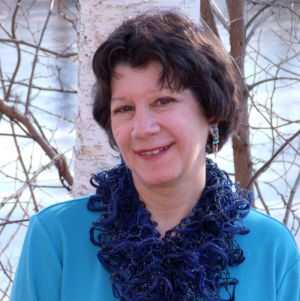 been online friends, and I was delighted that she drove all the way to Salem, New Hampshire this summer when I was signing at the Barnes and Noble there, just to meet me in person. Take it away, Linda! (Oh, and she’s giving away a copy of her debut mystery, Some Enchanted Murder, to a commenter.)
been online friends, and I was delighted that she drove all the way to Salem, New Hampshire this summer when I was signing at the Barnes and Noble there, just to meet me in person. Take it away, Linda! (Oh, and she’s giving away a copy of her debut mystery, Some Enchanted Murder, to a commenter.)
Writing what I know . . .
First, I’d like to thank Edith Maxwell for inviting me to guest blog with the Wicked Cozy Authors! I live in New Hampshire, but I’m an old Massachusetts gal from way back, so I feel right at home here with everyone.
As a lover of psychological suspense, I’d never pictured myself writing a cozy. For years I’d been devouring the books of authors such as Carlene Thompson, Wendy Corsi Staub, and Joy Fielding. Their heart-stopping novels kept me glued to the pages, so why would I want to write anything else? On my part, it was very short-sighted.
I first discovered that I wanted to write a cozy when I landed on a charming mystery many cozy lovers are familiar with, about a New Hampshire town in which everything is designed around books. The main character owns a mystery book store, and is surrounded by quirky characters in a delightful little village. By the time she solved the murder and wrapped up all the loose ends, I was completely and irrevocably hooked. I wanted to read cozies! More important, I wanted to write cozies. Thinking back to my teen years, I really shouldn’t have been surprised. Back when paperback mysteries cost seventy-five cents, Agatha Christie had been a huge favorite of mine. She evoked such enchanting visions of quaint English villages that I longed to travel to England, a dream I later fulfilled.
Okay, so now I wanted to write a cozy. Ah, but what to write about? We’ve all heard the old saw write what you know, but was it really the best advice? Well I wasn’t sure, since I’d read opposing views, but writing what I was familiar with sounded awfully good to me.
To write what I know, I had to rely on my job. In my day gig I work as a paralegal/title examiner for a title insurance company. Wait . . . don’t nod off yet. Examining titles in the Registries of Deeds, where evidence of land ownership is recorded, is a huge part of my job. So my main character would be a paralegal, I decided, and an expert at examining titles. Except that she would work for a tiny law office, not a big company; and she would live in a fictional town called Hazleton, New Hampshire. And because she needed a sidekick, I gave her a sixty-something aunt—a Realtor who tools around in her dead husband’s old gas guzzler and played Beatles music almost a round the clock.
round the clock.
It was the concept of creating the perfect clue that intrigued me the most. Once I’d latched onto the idea that the secret to the killer’s identity had to be hidden in the weighty volumes of the Registry of Deeds, I couldn’t let it go. The Rockingham County Registry worked perfectly for me. I needed my clue to date back to the early 1950s, and the Rockingham County indices stretch back to 1629.
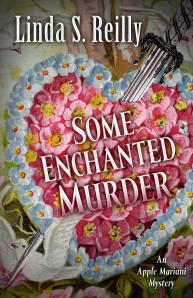 I still wasn’t sure I could make any of it work, but after a lot of false starts the mystery finally came together. A detailed rejection from one insightful editor set me on the path to a better story. I was grateful that I’d taken the advice to write what I know, because late in 2011 Five Star Publishing accepted Some Enchanted Murder for publication. The mystery debuted in March of 2013, and was a finalist for the 2014 Silver Falchion Award in the category “Best First Novel: Cozy, Traditional and Historical.”
I still wasn’t sure I could make any of it work, but after a lot of false starts the mystery finally came together. A detailed rejection from one insightful editor set me on the path to a better story. I was grateful that I’d taken the advice to write what I know, because late in 2011 Five Star Publishing accepted Some Enchanted Murder for publication. The mystery debuted in March of 2013, and was a finalist for the 2014 Silver Falchion Award in the category “Best First Novel: Cozy, Traditional and Historical.”
I’m currently writing a cozy series for Berkley Prime Crime called Deep Fried Mysteries. My main character is restaurateur Talia Marby, whose recently acquired fish and chips shop in the Berkshires morphs into a “deep fried” eatery. Talia and I are both new at the job, so together we’re experimenting with tasty recipes . . . all while solving murders, of course. The first book in the series, Fillet of Murder, will debut in May 2015.
Anyone who leaves a comment will be entered in a drawing for a hardcover copy of Some Enchanted Murder.
Readers – Questions for Linda about examining titles or deep fried food? Or anything else?
Armed with a degree in Criminal Justice, Linda Reilly once contemplated a career in law enforcement. But life took a twist, and instead she found her niche in real estate closings and title examination, where the dusty tomes in the Registry of Deeds enticed her into solving mysteries of a different sort. Her dream of one day having a story published happened in 1995 when a national magazine published her short mystery Out of Luck. Since then, she’s had over forty short stories published in Woman’s World magazine. Linda lives in southern New Hampshire with her husband, where she is currently working on her new Deep Fried cozy mystery series for Berkley Prime Crime. You can find her at www.lindasreilly.com
Filed under: Guest posts Tagged: Berkley Prime Crime, Fillet of Murder, Five Star Publishing, Linda Reilly, Rockingham County, Some Enchanted Murder, title search

October 10, 2014
Welcome Susan O’Brien
We are so happy to have Susan O’Brien with us today. Thanks for joining us!
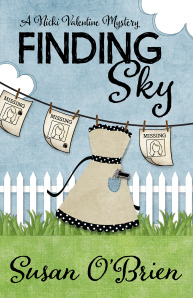 My first mystery, Finding Sky, was published this week, and I’m especially thrilled to celebrate with the Wicked Cozy Authors. That’s because although Finding Sky is set in the D.C. area, I plan to write in—and about—the most beautiful place I’ve ever been: the Damariscotta River in Maine. Side note: Maine is the first place I heard the word “wicked” used in a positive way. I was in elementary school, and since I’m a “word person,” it was unforgettable!
My first mystery, Finding Sky, was published this week, and I’m especially thrilled to celebrate with the Wicked Cozy Authors. That’s because although Finding Sky is set in the D.C. area, I plan to write in—and about—the most beautiful place I’ve ever been: the Damariscotta River in Maine. Side note: Maine is the first place I heard the word “wicked” used in a positive way. I was in elementary school, and since I’m a “word person,” it was unforgettable!
I’ve always wanted to be an author, and plenty of dreaming about it was done on childhood trips to my grandparents’ Maine property—a coastal paradise with its own beach, blueberry bushes, and soft, pine-needle walking paths. I adored gazing at the water, notebook and pen in hand, feeling inspired. It’s one of the few places I’ve ever written poetry.
 Once, a writer visited while we were there, and he took my passion for the craft so seriously that I can still picture him on the beach, chewing “spruce gum”—which he cut from a nearby tree and shared—treating me as an equal. What a gift.
Once, a writer visited while we were there, and he took my passion for the craft so seriously that I can still picture him on the beach, chewing “spruce gum”—which he cut from a nearby tree and shared—treating me as an equal. What a gift.
I hesitate to reveal too much, because someday, my protagonist Nicki Valentine will explore the same treasured location with her children. Seeing it through her eyes—with her sense of humor and romantic challenges—will be quite an adventure. (Although I did have a massive, totally unrequited crush on my hunky sailing instructor one summer. Hmmm. That could provide some inspiration!)
 I can’t wait to escape to Maine with Nicki and her family—literally. I’ve spent countless hours looking at real estate online, envisioning what it would be like to plot on a dock, clear my mind in a kayak, and make a riverside deck my “home office.” (During the winter, I plan to live in Florida, which involves a whole other real estate plan and imaginary budget.)
I can’t wait to escape to Maine with Nicki and her family—literally. I’ve spent countless hours looking at real estate online, envisioning what it would be like to plot on a dock, clear my mind in a kayak, and make a riverside deck my “home office.” (During the winter, I plan to live in Florida, which involves a whole other real estate plan and imaginary budget.)
In reality, I may have to rely on a research trip, Google, and the memories I’m lucky to have. And that’s plenty. The peace I felt in small-town Maine is enough to last a lifetime.
I’m curious, do you dream of writing in a special location? Which settings do you find most inspirational and why? Do you long to share a certain spot with your characters and readers? And as a reader, do you enjoy visiting new locales with protagonists? I look forward to hearing your thoughts!
Happy travels!
 Susan O’Brien has been passionate about reading and writing since childhood, when she started a neighborhood newspaper and escaped tween stress with mysteries. Since covering her first big story (the birth of gerbils next door), she has worked with USA TODAY, PI Magazine, The Parent Institute and others. Susan has an M.A. in forensic psychology and is a registered private investigator in Virginia. Among her diverse interests are photography, gardening, loud R&B music, healing prayer and reality TV. She lives with her husband and children in the D.C. suburbs and donates part of her earnings to missing children’s organizations.
Susan O’Brien has been passionate about reading and writing since childhood, when she started a neighborhood newspaper and escaped tween stress with mysteries. Since covering her first big story (the birth of gerbils next door), she has worked with USA TODAY, PI Magazine, The Parent Institute and others. Susan has an M.A. in forensic psychology and is a registered private investigator in Virginia. Among her diverse interests are photography, gardening, loud R&B music, healing prayer and reality TV. She lives with her husband and children in the D.C. suburbs and donates part of her earnings to missing children’s organizations.
Visit Susan on her website, Twitter, Instagram, and Facebook.
Filed under: Guest posts Tagged: Damariscotta River, Finding Sky, Henery Press, maine, Susan O'Brien

October 9, 2014
A Wicked Welcome to Hank Phillippi Ryan
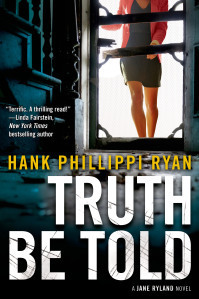 The Wickeds all know Hank Phillippi Ryan. She is a Sister in Crime, a friend, and a cheerleader. We had a great conversation, with the second half of the interview appearing over at Pen, Ink, and Crimes, the Sisters in Crime New England blog.
The Wickeds all know Hank Phillippi Ryan. She is a Sister in Crime, a friend, and a cheerleader. We had a great conversation, with the second half of the interview appearing over at Pen, Ink, and Crimes, the Sisters in Crime New England blog.
I want to talk about your books, especially Truth Be Told, the new Jane Ryland novel, but first I’d love to ask you a little bit about you. You had/have a huge career as a television reporter. Tell us a little bit about that.
Oh yes, I am still investigative reporter for Boston’s NBC affiliate. I’ve been a television reporter since… 1975! And so far have 32 Emmys for investigative reporting. Longevity does have its pluses.
I think it was on my mother’s influence, because when I was growing up she would never tell me the answer to anything. “Go and find out,” she would always insist. “Go ask for yourself.” So I learned how to ask questions, and how to be confident in research. It always seemed like fun to me, solving a puzzle and having an adventure.
I never planned to be a reporter, though. I thought I would be a geneticist, or an English teacher, or the lawyer for the Mine Workers. Finally deciding I wanted to change the world, I went into politics, and worked in several political campaigns. Sadly, no candidate I worked for actually won. Seemed like the universe was trying to tell me something!
Finally, with crossed fingers and a lot of nerve, I applied for a job as a radio reporter, This was 1971. I only got the job–and I know this is true–because I told them their license was up for renewal at the FCC and they did not have any women employees. Ta dah. The next day I had my first job in broadcasting. I took a chance—and found my first calling.
So I’m really proud to be part of breaking the gender barrier in broadcasting!
And if you ask me what the best story I’ve ever done is, I would say… It’s still to come.
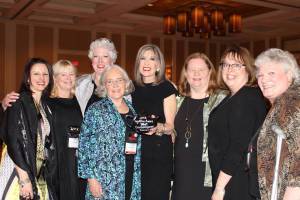
At 2013 Malice Domestic, celebrating Hank’s win for Best Contemporary Novel. From L-R Liz, Kate Flora, Julie, Edith, Hank, Barb, Sherry, and Mo Walsh
I’m glad to hear that! What made you start writing mysteries?
Oh, I always wanted to be a mystery author, ever since I was a little girl. Tess Gerritsen always says writers “self-select” at about age 7, and I sure did. I was all about Nancy Drew, and Sherlock Holmes, and even back then, Agatha Christie.
I loved the idea of being able to create a puzzle, that someone could then solve. But that the result would be surprising.
What was surprising… It wasn’t until maybe 40 years later that I actually had a good idea for a plot!
The moment I thought of it, secret messages in computer spam!, I got goosebumps, and I still do now. And from that moment I was obsessed with writing. I told my husband… I’m going to do this! No contract, no agent, and absolutely no idea of how publishing worked. But I was obsessed.
That turned out to be Prime Time, which won the Agatha for best first mystery.
And ever since then, writing mysteries has been at the top of my mind! I think about it all the time.
The newest, TRUTH BE TOLD, is a big exciting entertaining thriller, set in Boston–about a diabolical mortgage fraud scheme and a notorious cold case murder. And also about a reporter who fabricates stories.
It got starred reviews from Booklist and from Library Journal, which has the best review line I’ve ever seen: “Drop everything and binge-read until the mind-boggling conclusion!” Got to love that.
 The buzz on this book is great. I wonder, how has Hank influenced Jane Ryland?
The buzz on this book is great. I wonder, how has Hank influenced Jane Ryland?
That’s a wonderful question. The reason all of our books are special, and unique, is that only we could write them, correct? And I know Jane Ryland could not exist without me.
But Jane is, what, 30 years younger than I am? So what she’s going through now are cycles of life that I have already handled. And problems and decisions I have already faced, both personal and professional.
Still, she is not me! She is a new person, and that is part of the joy. It’s really amazing as she reveals herself to me… Her confidence and her fears and her vulnerability and her history and her goals.
She doesn’t always make the same decisions I would. And that surprise is also part of the fun.
Jane is much more confident than I was at 34, I can tell you that! But she is 34 at a different time in our culture than I was, see what I mean? (I’ll be 65 next week! Yeesh!)
Happy early birthday!! What can Jane do that you wish you could do?
Well, as an objective reporter, I am not supposed to have any opinions. And I certainly can’t comment on the state of journalism these days. Jane can.
And does.
I love that. Your first series featured Charlotte McNally, and was a more of a traditional mystery, with some cozy influences. Tell us a little about writing that series.
The Charlie series, which I think of as a mystery series, is a little bit more humorous – I guess, a lot more humorous than the Jane Ryland thrillers. They are in first person, only from Charlie’s point of view. So there’s a lot more internal dialogue. And that makes a huge difference in telling the story.
The Jane books are multiple point of view, past tense, third person. There’s Jane, and Detective Jake Brogan, and three others in each book!
I started doing writing that way because I knew the story of The Other Woman woman was so much “bigger” than a Charlotte McNally story could be .
And in the Jane books, including the new Truth Be Told, the tone is darker, and the events are more pervasively sinister. It has more of a big city feel, even though both series are set in Boston.
In a big thriller, the story can be so much more complex then it can be in a first-person traditional mystery. I still don’t write graphic sex or violence (though I certainly read books that include it!) It’s much more interesting to me as a writer to create anticipation and aftermath and imagination.
(More about Charlie in the next year or so!)
Can’t wait for the Charlie news! Last question, what do you wish your readers knew about you?
I’m so grateful for everything–but you knew that. And I’m so excited and nervous about Truth Be Told–but you knew that. And I am crossing fingers that you love it–but you knew that, too.
Thank you for visiting with the Wicked Cozys Hank! Readers, Hank will do a giveaway today to whet your appetite for Truth Be Told— one copy of The Other Woman and one of Agatha-winning The Wrong Girl.
About Truth Be Told:
TRUTH BE TOLD begins with an all-too-familiar tragedy in today’s headlines: a middle-class family evicted from their home in the suburbs of Boston. In digging up the facts on this heartbreaking story—and on other foreclosures—reporter Jane Ryland soon learns the truth behind a big-bucks scheme and the surprising players who will stop at nothing, including murder, to keep their goal a secret.
Boston police detective Jake Brogan may have a liar on his hands. A man has confessed to the Lilac Sunday killing, a long-unsolved murder that haunted Brogan’s police-commissioner grandfather. While Jake’s colleagues take the confessor at his word, Jake is not so sure.
In the meantime, Ryland and Brogan’s paths are once-again intertwined—and as their private relationship heats up, it may mean difficulties in their professional lives.
Financial manipulation, the terror of foreclosures, the power of numbers, the primal need for home and family and love… What happens when everything you believe is true turns out to be a lie?
HANK PHILLIPPI RYAN is the on-air investigative reporter for Boston’s NBC affiliate. She’s won 32 EMMYs, 12 Edward R. Murrow awards and dozens of other honors for her ground-breaking journalism. A bestselling author of seven mystery novels, Ryan has won multiple prestigious awards for her crime fiction: three Agathas, the Anthony, Daphne, Macavity, and for THE OTHER WOMAN, the coveted Mary Higgins Clark Award. National reviews have called her a “master at crafting suspenseful mysteries” and “a superb and gifted storyteller.” Her 2013 novel, THE WRONG GIRL, has the extraordinary honor of winning the Agatha Award for Best Contemporary Novel and the Daphne Award for Mainstream Mystery/Suspense, and is a seven-week Boston Globe bestseller. Her newest hardcover, TRUTH BE TOLD, is a Library Journal Editor’s Pick and RT Book Reviews Top Pick, with starred reviews from Booklist and from Library Journal, which raves, “Drop everything and binge read!” She’s a founding teacher at Mystery Writers of America University and 2013 president of national Sisters in Crime.
Filed under: Interview Tagged: Jane Ryland, Truth Be Told

October 8, 2014
What We Love About the Orchard Mysteries
Sheila Connolly’s Orchard Mysteries are now on the eighth book, Picked to Die. All the Wickeds have been inspired by Sheila’s writing in one way or another. Here’s what we love about the Orchard series.
Edith: Since I also write a Massachusetts-based farm series, the Orchard series has a  special draw for me. I have worked casual references to Meg’s apples into a couple of my Local Foods mysteries, too. Farming in the northeast, whether it’s vegetables or tree fruit, involves the stress of weather, good and bad; the vagaries of customer whims; market trends beyond the farmer’s control; the joys of self-employment balanced off the despair of a failed crop; and so much more. But beyond farming, I’ve been inspired by Sheila’s intelligent protagonist and her clear portrayal of small-town Massachusetts. Keep ‘em coming!
special draw for me. I have worked casual references to Meg’s apples into a couple of my Local Foods mysteries, too. Farming in the northeast, whether it’s vegetables or tree fruit, involves the stress of weather, good and bad; the vagaries of customer whims; market trends beyond the farmer’s control; the joys of self-employment balanced off the despair of a failed crop; and so much more. But beyond farming, I’ve been inspired by Sheila’s intelligent protagonist and her clear portrayal of small-town Massachusetts. Keep ‘em coming!
Jessie: I love the feeling the series evokes of small-town New England. The characters and the setting reflect life here in a genuine way that I appreciate and admire. And, I just love your covers!
 Julie: Meg is such a great character. I love watching her find herself, and become more and more a part of the community. And the timing of this series is perfect. Apple season. Orchard series. Life is good.
Julie: Meg is such a great character. I love watching her find herself, and become more and more a part of the community. And the timing of this series is perfect. Apple season. Orchard series. Life is good.
Liz: I love reading the Orchard books in the fall! It’s just got the best fall-in-New-Englandy feel. Sheila’s writing is flawless, and the stories just pull me in. Her characters are fun and totally relatable. What’s not to love?
Barb: Like everyone else, I love the New England setting, but my very favorite thing is that the Orchard Mysteries are about grown-ups. Yes, they’re certainly cozies, but Meg and Seth are adults with adult challenges and preoccupations. Character, and the great writing, are what keep me coming back to this series.
Sherry: My husband recently startled me by saying he reads books for plot. I argued that he wouldn’t read a series if he didn’t like the characters. Sheila, in all her series, writes interesting characters with intriguing plots and a great setting. The Orchard Mysteries hold a special appeal because they make me think of my grandparents amazing orchard in Missouri.
Filed under: Wicked Wednesday Tagged: Orchard Mysteries, Picked to Die, sheila connolly

October 7, 2014
Wicked Happy Book Birthday Sheila Connolly!
It feels like we have book birthdays for Sheila three times a year. Oh, wait–we do! Today is the birthday of Picked to Die the eighth book in Sheila’s flagship Orchard Mystery series. Let’s see what it’s about.
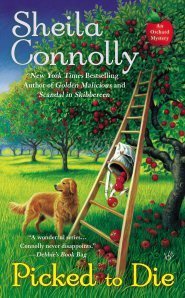 A TREE IS KNOWN BY ITS FRUIT
A TREE IS KNOWN BY ITS FRUIT
It’s harvest time in Granford, Massachusetts, and orchard owner Meg Corey and her fiancé, Seth, are both racing to beat the New England winter. Meg is bringing in her apple crop with a team of workers, while Seth is working to restore an old building in the center of town. But when his project is set back due to the unexpected discovery of a skeleton under the building—and even worse, a young man related to one of Meg’s former apple pickers is found dead behind the local feed store—the couple’s carefully laid plans are quickly spoiled…
Meg can’t help but wonder: are they just unlucky, or is there something rotten in Granford? If so, she knows she’s got to seek out the bad apple before it ruins the whole bunch…
Barb: Happy Book Birthday, Sheila! Hard to believe this is the eighth Orchard Mystery. I’ve been around so long, I remember when you announced the deal at a Sisters in Crime New England meeting. Does it ever get old?
Edith: I remember that meeting, too! It was my 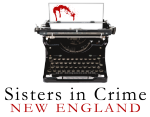 first SINC NE meeting, at Kate Flora’s house. So many congrats on your continued success. I love all three of your series, but I think I like the orchard series the best, so I can’t wait to read Picked to Die.
first SINC NE meeting, at Kate Flora’s house. So many congrats on your continued success. I love all three of your series, but I think I like the orchard series the best, so I can’t wait to read Picked to Die.
Sherry: I’m so happy for you, Sheila! I don’t know how you manage three series and your romantic suspense but as a reader I’m grateful you do!
Jessie: Sheila, you are an inspiration to us all! Thanks for showing us it can be done!
 Julie: Barb and Edith, I remember that meeting too! Sheila, happy book birthday!! I love the Orchard series, and can’t wait to read this one. I may need to go apple picking this weekend to celebrate–and of course, get some apple cider doughnuts.
Julie: Barb and Edith, I remember that meeting too! Sheila, happy book birthday!! I love the Orchard series, and can’t wait to read this one. I may need to go apple picking this weekend to celebrate–and of course, get some apple cider doughnuts.
Liz: Sheila, so happy for you. You’re truly an inspiration. I love this series, and can’t wait to get to this book. Wishing you many more series and much success!
Readers: Which of Sheila’s books have you read? (Or, why haven’t you?) Any questions for this NYT-bestselling, award-winning, super-productive, and extraordinarily nice (and generous) author?
Filed under: Book Release Tagged: Berkely Prime Crime, kate flora, Orchard Mysteries, Picked to Die, sheila connolly, Sisters in Crime New England

October 6, 2014
Stuff
by Sheila Connolly
For the past decade or more, I’ve harbored the fantasy of buying a cottage in Ireland. At first I was fixated on buying the site where my Connolly family originated, but I was discouraged by several things: (1) I had no job at the time, so no money, (2) the place was falling down since it hadn’t been lived in for half a century, (3) the farmer who lived next door used the space behind the house for his very large manure pile, and (4) there was a rather aromatic piggery up the hill. All excellent reasons not to buy that property!

Not the family home, but the way I wish it looked.
But the dream persisted through the years, and through a lot of changes in my life. So I have to ask myself why the idea still appeals to me, and I didn’t come up with one simple answer, but multiple ones:
–family ties, obviously—although none of my family lives in that part of West Cork now
–owning a place that is uniquely mine (without my husband’s name on the mortgage or title)
–the romance of the idea—most Americans I mention it to seem to love it, and wondered when they could come visit
–the Irish people I’ve talked to about the idea say it’s a good time to buy since the market has bottomed out
–the area is pretty and peaceful and quiet and you can see the Milky Way at night, and I can imagine getting good work done there as long as I had a wi-fi connection
–and finally, it would be like starting over—minus all my stuff.
I have a lot of stuff. I’ve written about it before, and I’m horrified that not much has changed. I haven’t undergone some miraculous transformation and purged my house (too big for two people!) of non-essential items. Although we did rent a dumpster and dispose of over THREE TONS of accumulated construction debris, plus odds and ends that prior owners had left behind (but not that Civil War cannonball I found under the house, a relic from a previous owner who was a Civil War veteran).
Why do I haul this issue out again? Well, in August I spent ten days in a rented apartment in Ireland, which I’d booked sight unseen. It was built over a garage, and it might have measured 15×40 feet all in (two rooms plus bath). I will say that it was very nicely fitted out, and had all the necessary amenities, and it was scrupulously clean, and even had free wi-fi. It became home very quickly during the short time I was there, but it was really suitable for only one person (which was fine since I was traveling alone). Add one more body and you’d be tripping over each other all the time.

My tiny kitchen (that’s the oven, not the microwave!)
With limited space you start thinking about what you really need. The kitchen-end of one room there drove that home most clearly. There was a two-burner stove, an oven that might hold a casserole if you left the top off, a fridge about one foot deep, a microwave, and a dishwasher. I never even opened the dishwasher, but I did use everything else. I even cooked! But it made me think: how would I have done things differently in the same space? (Skipped the dishwasher for sure.)
Don’t get me wrong: I love my stuff. Some of it is inherited, and it comes with memories of my family members attached. Some of it I’ve bought myself, and I can tell you when and where and why for almost all of it. When I see an item or hold it, I remember. I understand why “souvenir” is such an important concept—the word means “memory” in French—and having that tangible thing takes you back to a place and time from your past.
But even so, there’s something appealing about starting fresh, with a blank slate. And no matter how much I love my assembled clutter, it’s unpeaceful.
Writing is sometimes like that, especially if you’re writing a series. The first book is that blank slate, and you can fill it with people and places and things however you choose. But then there’s a second and a third (and if you’re lucky, even more), and you start collecting baggage. If a character appears in one book, do they have to come back? (Assuming you haven’t killed them.) Are you stuck in one place or can you visit others? If they’re living in one place, they must have surrounded themselves with something—furniture, knickknacks, books. And don’t forget the pets—you can’t just make them disappear.
So by the time you’ve written a few books in a series, things are getting a little crowded. Just like in life. Stuff happens.
The eighth book in the Orchard Series, Picked to Die, comes out tomorrow. When I began the series, my heroine Meg went from a Boston apartment to living in a 1760 colonial house with a barn, and one of the first things she added was a pair of rescue goats. Talk about a change in lifestyles! Curiously, she really isn’t into acquiring more stuff. She hasn’t spent a lot of time worrying about furniture or new curtains. I have to keep reminding myself: I created her. Is she mirroring my own (buried) feelings about accumulating stuff, or am I letting her try out a more streamlined space for me?
As Henry David Thoreau said, “Simplicity, simplicity, simplicity!”
It’s been a busy few weeks on the book front:
Seeing the Dead, the sequel to last year’s Relatively Dead, came out on September 21st. Find it on Amazon and Barnes & Noble.
Picked to Die (Orchard Mystery #8) comes out tomorrow, October 7th. (Amazon, Barnes & Noble.)
Reunion with Death is part of a BookBub promotion through October 11th, and is priced at 99 cents. (Yes, on Amazon and Barnes & Noble.)
Filed under: Sheila's Posts Tagged: clutter, Henry David Thoreau, Ireland, sheila connolly, simplicity, souvenir

October 3, 2014
Opening Lines
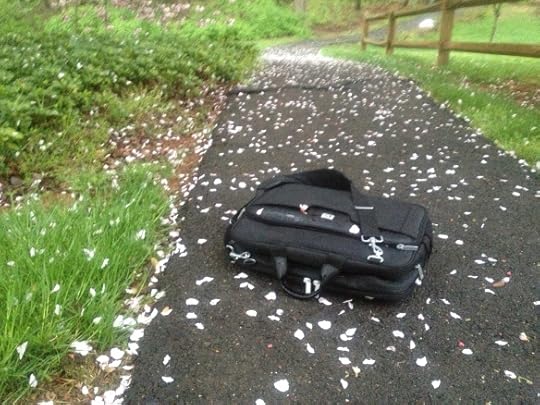 Edith: I TOLD him not to drop the damn laptop case. Those innocent little cherry blossoms were about to be blown right back to Tokyo.
Edith: I TOLD him not to drop the damn laptop case. Those innocent little cherry blossoms were about to be blown right back to Tokyo.
Jessie: Miles took one look at the beauty all around him and dropped everything to start a new life as a park ranger.
Barb: “I’ve told you officer. He walks our daughter to kindergarten every morning through the park. When the school called asking why she was absent, I rang his office. He never arrived. I ran out here and this is all I found.”
Julie: The Wicked Witch was out of ideas, until she saw the cherry blossoms dropping along the path. Dorothy would never guess that this was poppies 2.0. Serves her right. A lawyer? She goes back to Kansas to become a lawyer? Really? “I’ll get you, my pretty,” she said. “And your little Filofax too.”
Sherry: If he loved me as much as he loved the laptop, I might not have started tossing things out the window.
Filed under: Opening Lines Tagged: briefcase, Charlie Parker, cherry blossoms, Kansas, laptop, opening lines, Tokyo, Wicked Witch

October 2, 2014
Wouldn’t It Be Deadly–An Interview with D.E. Ireland
by Barb, enjoying fall in the Berkshires this week
First order of business–St. Martin’s has agreed to give away a copy of Wouldn’t It Be Deadly to two lucky commenters below–so jump aboard!
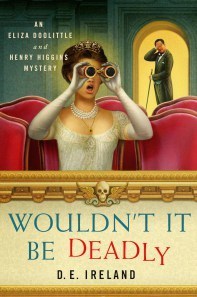 I’ve been excited about D. E. Ireland’s
Wouldn’t It Be Deadly
ever since I first heard the concept–Shaw’s Henry Higgins and Eliza Doolittle as sleuths. Who hasn’t wondered what happened after the curtain went down?
I’ve been excited about D. E. Ireland’s
Wouldn’t It Be Deadly
ever since I first heard the concept–Shaw’s Henry Higgins and Eliza Doolittle as sleuths. Who hasn’t wondered what happened after the curtain went down?
D.E. turns out to be the writing team of Meg Mims and Sharon Pisacreta. I first met Meg at Malice Domestic in 2013. Wouldn’t It Be Deadly was complete and they were seeking representation. Meg asked if she could contact my agent, John Talbot, and say I recommended him. I said, “Of course, just don’t say I’ve read your book and I loved it.” Which, to be clear, Meg would never, ever do, but I always say that because you never know.
It must have gone well, because it seemed like three weeks later, I got an e-mail from Meg saying that not only had John accepted the book, but he had sold the series! So I do feel, a teeny, tiny bit like one of the (many) fairy godmothers of Wouldn’t It Be Deadly.
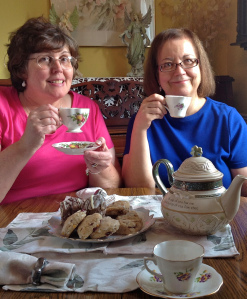 I’ve always been fascinated by writing teams, partly because I’ve never done it successfully. So when I had a chance to interview Meg and Sharon, that’s what we talked about.
I’ve always been fascinated by writing teams, partly because I’ve never done it successfully. So when I had a chance to interview Meg and Sharon, that’s what we talked about.
Barb: You’re writing the Eliza Doolittle and Henry Higgins Mysteries as a team. How did this come about? How do you know each other? Have you written together before?
Sharon: We met in college as anthropology undergraduates; my specialty was archaeology and history, Meg’s was linguistics. While I was already published in short fiction, it was only in the early 1990s that both of us began to write our own novels. Friends for nearly a decade by then, it seemed natural for Meg and I to became critique partners. This helped us to understand the other person’s strengths and weaknesses as a writer. The Eliza Doolittle/Henry Higgins series is our first attempt at writing together, although we had been looking for the right vehicle for a long time. And those years of critiquing each others’ manuscripts was an invaluable training ground for our eventual partnership as D.E Ireland. We knew each other’s writing style quite well, so there were few surprises when we finally began to work as a team.
Meg: Oh, there’s been some surprises along the way, but things have worked out very well. In the past, we acted as a sounding board for each others’ work, so now the brainstorming on a shared project is double the fun. We both had the same idea just the other day when I stumbled across some research! So while we “think alike” in some ways, we each have a different perspective on promotion, on villains, on what “too much detail” means, etc. Sharon can channel Higgins in ways I’d never dream of, and I’ve managed to channel Eliza – but we both take turns channeling each character. We have to know every character, from backstory to how they act and react.
Barb: So how does the writing work? Alternating chapters? One person outlines, the other writes? One does revisions? I’m dying to know. And did you find your rhythm of writing together right off the bat, or did it take awhile?
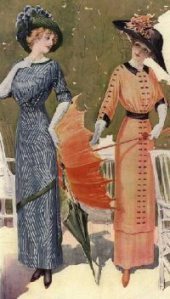 Sharon: A meticulously detailed outline is mandatory. As part of a writing duo, we have to literally be on the same page – or at least be aware of what the other partner is going to write about on that page. Both of us know exactly what is planned for each chapter and scene before we write the first sentence of the book. We discuss everything we want to do in the book, but I’m usually the one who actually writes up a monster of an outline – which makes Meg sigh in weariness. The outline changes often during the first draft as new ideas occur to us and original ideas start to look not so interesting. But changes are mutually agreed upon along the way. As for who writes what? Our initial plan was that we each write two consecutive chapters, alternating in this way for the whole manuscript. I tend to write faster than Meg, so sometimes we just agree among ourselves who is going to write a particular chapter. We may write alternating single chapters for the third book, so we’ll see how that works this time around.
Sharon: A meticulously detailed outline is mandatory. As part of a writing duo, we have to literally be on the same page – or at least be aware of what the other partner is going to write about on that page. Both of us know exactly what is planned for each chapter and scene before we write the first sentence of the book. We discuss everything we want to do in the book, but I’m usually the one who actually writes up a monster of an outline – which makes Meg sigh in weariness. The outline changes often during the first draft as new ideas occur to us and original ideas start to look not so interesting. But changes are mutually agreed upon along the way. As for who writes what? Our initial plan was that we each write two consecutive chapters, alternating in this way for the whole manuscript. I tend to write faster than Meg, so sometimes we just agree among ourselves who is going to write a particular chapter. We may write alternating single chapters for the third book, so we’ll see how that works this time around.
We’re also equally involved with revisions. When we have written our “assigned” first draft chapters, we exchange them and the other partner edits and revises them using Word’s Review/Track Changes option. But the other person does not see what changes have been made to those revised chapters until the first draft is finished. Meg and I have known each other since the early 1980s. We’ve been through a lot together. And it is that shared history and long friendship that keeps us from strangling each other when we do disagree on a passage or even a sentence in the manuscripts.
Meg: That outline is both incredible (I’m jealous, really) and terrifying. I’ve learned to write “to spec” so that’s been pretty cool, although characters might spin things in a new way. We write rough drafts differently – mine are literally rough, while Sharon polishes her roughs – but that’s something I’ve altered as well. I am slower, but when the Sicilian cracks the whip, I churn faster! Sharon writes overflow, while I write tight. But the end result makes a solid book.
Barb: What happens when there’s controversy? Disagreement over plot or character or series direction? How do you decide?
Sharon: Usually disagreement begins with email messages questioning what the other person is doing in a particular chapter or scene. I should explain that Meg lives three hours away from me, so our communication is often via phone and email. (This translates to daily phone calls and endless email messages.) Sometimes the emails become rather testy and even heated. After all, writers are passionate about their prose. But any tension between us has never lasted longer than several hours or at most overnight. We simply can’t afford to waste time arguing and have always been able to come up with a solution both of us can live with. Our attitude is that the quality of the book is all that matters, not our egos. Even more important, our long friendship is worth more than any book contract. I am sure Meg would agree when I say that we would walk away from D.E Ireland before we’d let the any writing conflicts threaten our friendship.
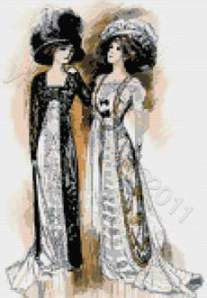 Meg: Sharon’s right, although… (just kidding!) The book’s quality takes precedence, and we’ve always compromised to that end. We both know how to bend – I came up with a research detail I couldn’t cut, and Sharon let it stay in because sometimes, some things are just too good. We’re both total research hounds, so we understand that. And we’re committed to take this series in exciting ways, since the premise is awesome. The more we learn about Eliza and Higgins, the more things have gone in directions we didn’t expect – especially in book 2. We can’t wait to write another.
Meg: Sharon’s right, although… (just kidding!) The book’s quality takes precedence, and we’ve always compromised to that end. We both know how to bend – I came up with a research detail I couldn’t cut, and Sharon let it stay in because sometimes, some things are just too good. We’re both total research hounds, so we understand that. And we’re committed to take this series in exciting ways, since the premise is awesome. The more we learn about Eliza and Higgins, the more things have gone in directions we didn’t expect – especially in book 2. We can’t wait to write another.
Barb: Not a team writing question, but I’ve seen lots of books about historical figures turned to sleuths, and of course treatments of famous sleuths like Sherlock over and over again, but I’ve never seen a book quite like yours. Where did the idea come from? What sort of obligation do you feel to Shaw and to your audience who may believe they know the characters well?
Sharon: Meg is the one who had the brilliant idea while driving over to see me one day, so I’ll let her tell it. As for our obligation to Shaw, it is huge. There would be no mystery series without his marvelous Eliza Doolittle and Henry Higgins. Everything we do in the series is based on his public domain play Pygmalion. This includes the favorite phrases of his characters and Shaw’s description of Higgins’s phonetics laboratory or his mother’s Chelsea flat. However Meg and I did take a few liberties regarding other characters in Pygmalion. For example, Shaw wrote that Freddy Eynsford Hill’s sister Clara becomes an owner of a furniture business. Where is the fun in that? So we have other plans for Clara that I believe would quite surprise Shaw. Otherwise we try to stay true to the spirit of the play. And we hope fans of Shaw’s Pygmalion and the musical My Fair Lady it inspired will feel they are revisiting beloved old friends and locales. Above all, we want to entertain the reader and hope they have a bit of fun watching Eliza and Higgins solve a murder or two.
Meg: ‘And oooooh, what a loverly feeling’ – when I was driving on the highway, singing along to the soundtrack, it hit me. Good golly, had any other writer thought of pairing Eliza with Higgins as amateur sleuths? Once I shared the idea with Sharon, we checked and voila! We had a new series. While it took us a year to write the first book of our ‘secret project’, things happened like lightning when our agent offered representation three hours after a one-paragraph email query. And he sold the series in three weeks.
Barb: What’s next writing-wise–both for D.E. Ireland and for you individually?
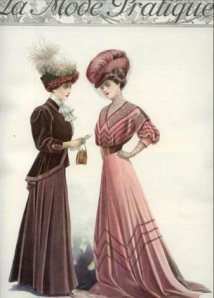 Sharon: Move Your Blooming Corpse, our second Eliza Doolittle/Henry Higgins book, was sent to our editor in early September. With a Sept. 23rd release date for Wouldn’t It Be Deadly, promotion (book signings, a book launch tea, blogging etc.) should take up most of our time until mid-October. After that we begin working on a detailed outline for Book Three. November is all about Bouchercon and editorial revisions for Blooming. But we will spend the long Michigan winter hammering out a first draft for the next book. I also currently have a proposal with my agent for a contemporary cozy mystery series set in a little village along the shores of Lake Michigan, which is also my current home.
Sharon: Move Your Blooming Corpse, our second Eliza Doolittle/Henry Higgins book, was sent to our editor in early September. With a Sept. 23rd release date for Wouldn’t It Be Deadly, promotion (book signings, a book launch tea, blogging etc.) should take up most of our time until mid-October. After that we begin working on a detailed outline for Book Three. November is all about Bouchercon and editorial revisions for Blooming. But we will spend the long Michigan winter hammering out a first draft for the next book. I also currently have a proposal with my agent for a contemporary cozy mystery series set in a little village along the shores of Lake Michigan, which is also my current home.
Meg: I can’t wait to see how Deadly does, both in reviews and sales. I’m really excited for Blooming as well – and I’m raring to go with more books in the series. But I’ve got several other projects to finish, including a Christmas novella with a dog that should be out before Bouchercon or shortly after, I hope! I’m working on a western mystery series, plus a contemporary cozy series as well. No rest for the weary! Being a full-time writer is fun, but it’s also hard work. It’s what I always dreamed of as a career, but I still read plenty and enjoy time with friends and family.
Barb: Readers- what do you think? Henry Higgins and Eliza Doolittle as sleuths. Leave a comment and win a book.
BUY LINKS:
Amazon
B&N
FOLLOW THE AUTHOR
www.deireland.com
www.deireland.com/blog
BIO
D.E. Ireland is a team of award-winning authors, Meg Mims and Sharon Pisacreta. Long time friends, they decided to collaborate on this unique series based on George Bernard Shaw’s wonderfully witty play, Pygmalion, and flesh out their own version of events post-Pygmalion.
Filed under: Guest posts Tagged: Eliza Doolittle, George Bernard Shaw, Henry Higgins, John Talbot, Meg Mims, Pygmalion, Sharon Pisacreta, team writing

October 1, 2014
Wicked Wednesday: What Do You Read When You’re Writing?
 The discussion is age-old. Some writers say they can’t read, or can’t read in their genre, when they’re writing. Others say, “If I had to give up reading in order to write, I’d give up writing.”
The discussion is age-old. Some writers say they can’t read, or can’t read in their genre, when they’re writing. Others say, “If I had to give up reading in order to write, I’d give up writing.”
Wickeds, do you read when you’re writing? If not, why not? If so, what do you read? Is your reading restrained in any way? Does it make a difference whether you’re writing a first draft or doing a polish? When do you read for research?
Inquiring minds want to know.
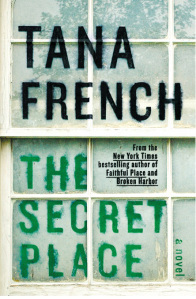 Liz: Love this topic! I find reading depends more on my overall mood than what I’m actually working on. Since most of what I read is mystery/crime, it varies between cozies, thrillers and other types of crime. That said, I don’t have nearly as much time to read as I would like…but that’s really the only limitation I have when it comes to reading. I can read any fiction, any time. I read for research as the need arises, or as the mood strikes. Sometimes I veer off into the world of business books, but I quickly return to my beloved mysteries.
Liz: Love this topic! I find reading depends more on my overall mood than what I’m actually working on. Since most of what I read is mystery/crime, it varies between cozies, thrillers and other types of crime. That said, I don’t have nearly as much time to read as I would like…but that’s really the only limitation I have when it comes to reading. I can read any fiction, any time. I read for research as the need arises, or as the mood strikes. Sometimes I veer off into the world of business books, but I quickly return to my beloved mysteries.
Right now, I’m catching up on my cozies – recent releases from my fellow Wickeds and a Natural Remedies Mystery I’m blurbing. Next up – the new Tana French book. Can’t wait!
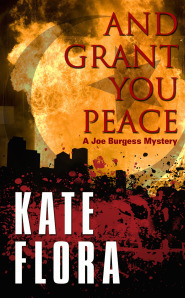 Edith: I find I have such little time for reading, if I didn’t read while I am writing, I’d never read. I certainly read for research both while I’m creating and while I’m polishing: Whittier’s biography, or the history of Brown County, Indiana, for example. But I also read cozy mysteries, New England-based police procedurals, suspense novels. They don’t seem to interfere with my writing or revision process, other than making me look more closely at my own work to make sure it’s as clear, lyrical, and deeply drawn as I can make it.
Edith: I find I have such little time for reading, if I didn’t read while I am writing, I’d never read. I certainly read for research both while I’m creating and while I’m polishing: Whittier’s biography, or the history of Brown County, Indiana, for example. But I also read cozy mysteries, New England-based police procedurals, suspense novels. They don’t seem to interfere with my writing or revision process, other than making me look more closely at my own work to make sure it’s as clear, lyrical, and deeply drawn as I can make it.
Right now, in final revisions on one book and starting revisions on another, I’m fittingly sitting in Maine reading Kate Flora’s new (Portland, Maine based) Joe Burgess mystery, And Grant You Peace.
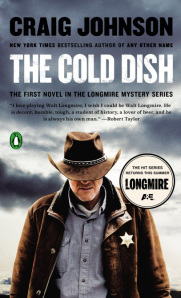 Julie: I try to read while I am writing. BUT I find that the ability to just read, and not dissect, is gone while I am writing. For example, I am reading the Longmire books in preparation for Crime Bake. Craig Johnson is the Guest of Honor, and I am going to interview him at lunch during the conference. First paragraph, my “oh he writes in first person. Wonder how this works in a long series…” kicks in. It is hard to turn the writer off.
Julie: I try to read while I am writing. BUT I find that the ability to just read, and not dissect, is gone while I am writing. For example, I am reading the Longmire books in preparation for Crime Bake. Craig Johnson is the Guest of Honor, and I am going to interview him at lunch during the conference. First paragraph, my “oh he writes in first person. Wonder how this works in a long series…” kicks in. It is hard to turn the writer off.
Edith: Agree with you on the dissection habit, Julie. It’s given me no patience for poorly written books. There isn’t enough time in the universe to read a book I see glaring writing errors in – point of view hops, too much telling not showing, and so on.
Jessie: I used to only read non-fiction when I was working on first drafts. I was really concerned about unintentionally matching the tone of what I was reading in my own work. As time has passed my confidence in my own voice has gotten stronger and I no longer worry about what I read. Like Edith, I read a lot of books for research and I do tend to read those voraciously whilst creating a first draft.
At any given time I am in the midst of several books. I get a little panicky if I don’t have at least a few books waiting in the wings. As a matter of fact, I bought a house next door to a public library partially influenced by that concern. Currently, I am part-way through a Swedish crime novel, a book about the relationship between Harry Houdini and Arthur Conan Doyle and a book on the history of the tarot.
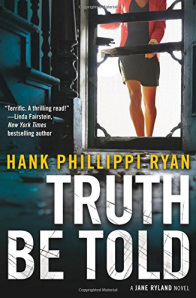 Barb: If I couldn’t read while I’m writing, it would be a close and agonizing call, but I would probably give up writing. Reading, after all, was my first love. Being a professional writer does crowd your reading time. There are books for research and books for blurbs. If you’re moderating a panel or conducting an interview at a conference, as Julie is, you’ve got a lot of books to read. Somehow or another it all piles up. But to be my best and happiest self, I have to read books I love, books that I wish I could have written. Kate Flora (I love the Joe Burgess novels, too) has a tradition where she allows herself to read anything she wants between Christmas and New Years. I’ve taken this tradition and expanded it (I’m a slow reader) to anything I want between the New England Crime Bake (Veteran’s Weekend) and New Years. It’s the ultimate luxury. Up this year will be Deborah Crombie, Louise Penny, Craig Johnson, Hank Phillippi Ryan, and (fittingly) Kate Flora.
Barb: If I couldn’t read while I’m writing, it would be a close and agonizing call, but I would probably give up writing. Reading, after all, was my first love. Being a professional writer does crowd your reading time. There are books for research and books for blurbs. If you’re moderating a panel or conducting an interview at a conference, as Julie is, you’ve got a lot of books to read. Somehow or another it all piles up. But to be my best and happiest self, I have to read books I love, books that I wish I could have written. Kate Flora (I love the Joe Burgess novels, too) has a tradition where she allows herself to read anything she wants between Christmas and New Years. I’ve taken this tradition and expanded it (I’m a slow reader) to anything I want between the New England Crime Bake (Veteran’s Weekend) and New Years. It’s the ultimate luxury. Up this year will be Deborah Crombie, Louise Penny, Craig Johnson, Hank Phillippi Ryan, and (fittingly) Kate Flora.
 Sherry: Of course I read when I write. I read lots of thrillers and mysteries. The only thing I try to stay away from is any book that has a similar theme to mine. I agree with the other Wickeds that reading good books makes me a better writer and makes me work harder. Right after I read an early copy of Clammed Up I had the opportunity to write the proposal for the garage sale series. I loved Barb’s character Gus and I think he influenced my character, Angelo. The good news is when I told Barb, she was surprised and didn’t think I’d copied Gus. Angelo is quirky in his own way.
Sherry: Of course I read when I write. I read lots of thrillers and mysteries. The only thing I try to stay away from is any book that has a similar theme to mine. I agree with the other Wickeds that reading good books makes me a better writer and makes me work harder. Right after I read an early copy of Clammed Up I had the opportunity to write the proposal for the garage sale series. I loved Barb’s character Gus and I think he influenced my character, Angelo. The good news is when I told Barb, she was surprised and didn’t think I’d copied Gus. Angelo is quirky in his own way.
Readers: What’s your take? If you’re a writer, do you read while you’re writing? If you create other kinds of art, can you absorb art by others while you’re creating?
Filed under: Wicked Wednesday Tagged: And Grant You Peace, clammed up, Craig Johnson, deborah crombie, Gus, hank phillippi ryan, I Shall Not Want, Indiana, Joe Burgess Mysteries, John Greenleaf Whitter, julia spencer-fleming, kate flora, Longmire, louise penny, Natural Remedies Mysteries, New England Crime Bake, Sarah Winston Garage Sale Mystery, tana french, Truth Be Told


